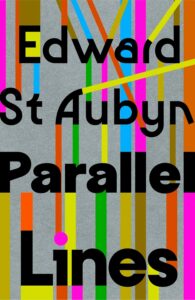My take on the new novel by this Booker Prize winning author, in which the lives of a disparate set of characters suddenly intersect.
Parallel lines are a bad premise for a novel. Fiction comes into being when characters crash into each other with unexpected results. If people stay neatly travelling on their own parallel lines, you don’t have a novel—you have an episode of Norwegian slow TV.
Fortunately, Edward St Aubyn preserves the parallel lines only for the first half of the book, before ignoring the title of his novel and making those lines crisscross and intersect. This is a novel of multiple characters and different threads, but the most interesting collision is between Sebastian and Olivia, twins who were separated at birth and had never met before (except at a party a few years earlier, when they chatted briefly without realising they were siblings).
Olivia was adopted at birth by Martin and Lizzie Carr, who are more or less the ideal parents: as professional psychoanalysts, they are emotionally aware and supportive, as well as being affluent enough to give her a good start in life. She goes on to become a researcher at Oxford and later a BBC radio presenter. Her twin brother, Sebastian, on the other hand, stayed with his birth parents—an abusive father and ineffective mother—before later being adopted by a couple who seemed not to be much better. He experiences severe mental illness and is in a Suicide Observation Room when we first meet him.
As it turns out, Sebastian’s psychoanalyst just happens to be Martin Carr, Olivia’s father. This is revealed quite early in the book, so I don’t consider it a spoiler. In fact, it was the one part of the story that I found difficult to accept. I know people in this profession, and they’ve told me that having a personal connection to a patient is a serious ethical breach. Martin is presented in the book as a kind, caring and professional man, a good father and a good analyst, so I find it extraordinary that he would allow this breach to go on for years without simply referring Sebastian to a colleague.
But if you can accept that, it does make for a delicious premise. When Olivia and Sebastian finally meet, Martin must feign ignorance as he talks to each of them in turn. How long will it be before they discover that they share not just the same “Bio Mum” but also the same “Psycho Dad”?
The answer comes towards the back end of the book, in an extended chapter in which we see all of the main characters preparing to attend the same gallery opening in central London. St Aubyn does a great job of stretching this part out, making good use of the large supporting cast to keep the tension going for as long as possible, before finally those parallel lines intersect.
Along the way, we get some beautiful writing and fascinating dialogue. The characters’ conversations are far more witty and insightful than any I’ve heard even when people are performing at dinner parties, let alone in the mundane domestic settings where most of the conversations take place. Here’s Martin, for example, speaking about the politics of resentment:
“The politician who knows how to stir it up will always win—making people proud of what they used to be ashamed of is such an intoxicating alchemy.”
There are loads of nuggets like that throughout the book. I’m not sure if people really talk that way—even Olivia’s five-year-old son Noah is a budding intellectual—but it’s wonderful to read.
The early sections with Sebastian are a brilliant and utterly convincing insight into the mind of a person who is constantly free associating, his thoughts jumping from topic to topic at lightning speed, connected by obscure but strangely logical lateral thinking. His first spoken words in the novel would be easy to see as unhinged ravings:
“By that fat cow! …. We’ve upgraded you from a classic Having room to one of our superior Being rooms … Give it a rest, me old son … I don’t want to be radicalised.”
But these outbursts take place several pages apart, and St Aubyn also takes us through Sebastian’s intervening thought processes, revealing a mind that is making creative associations which he just can’t control. As the book progresses, he begins to get more control over his thoughts and words, but he still has a tendency to spin from one thought to the next in unusual ways, sometimes to his advantage and sometimes not. It’s a sensitive portrait of mental illness that makes Sebastian into a very interesting and surprising character.
Large themes are strewn throughout the book, explored both through the characters’ erudite conversations and through aspects of the plot. Since there are two psychoanalysts and one patient at the heart of the novel, the functioning of the human mind is central, but there’s also the role of religion, the looming threat of climate change and species extinction, the nature and extent of compassion, and more.
Light also plays a major role in the novel. The gallery opening at which all the parallel lines cross is an exhibit of light art—installations that use light in creative ways to challenge the viewers’ perceptions. One of the hospital nurses, who later becomes Sebastian’s friend and invites him to the opening, is also a light artist, and another minor character, Hunter, is a tech billionaire who wants to install pieces of light art on his expansive property. I haven’t quite thought through the symbolism of it, but I suppose it’s about the interconnectedness of the characters, the way they’re all groping towards a light of understanding that, as in one of the main art pieces, was “there all along”, even in what seems like darkness.
So what happens when those parallel lines do intersect? Not as much as I’d hoped. I won’t spoil it by giving details because this really is the climax of the novel, but I thought St Aubyn could have made more of the fallout from the gallery opening at which all of the characters meet and Martin’s secret comes out. The ending felt satisfying on some levels but incomplete on others, with the central conflict only briefly explored and multiple loose ends left hanging with the minor characters.
After finishing the book and reading up about it online, I realised that this novel is part of a larger series. It’s a sequel to Double Blind, which I haven’t read, and although I don’t think there are more books officially lined up, the ending strongly suggests to me that there will be. The author’s previous Patrick Melrose series spanned five novels over the course of a decade, so I suspect this will be a similar multi-part series.
That explains the ending that left me wanting more, as well as the multiple plot lines that were introduced but didn’t really go anywhere. Some, I now realise, are continuations of storylines from Double Blind, and others, I imagine, will be more fully developed in the next installment. So although Parallel Lines does have a lot to offer as a standalone novel, I think you’d probably get more from it if you read it as part of the whole series.





There are 8 comments
I don’t know if it’s your writer’s nature but you make these books reviews a fascinating read that leaves me wanting to read the books. However, with this one, I am not sure if I want to invest on the series. I still have your book, A Virtual Love, I don’t forget it. I hope to read it no later than this summer!
Oh, thanks so much, Silvia! I mainly write these reviews to organise my thoughts about what I’ve read, but I also want to make them interesting for people, so I’m very happy to hear your reaction. And I hope you enjoy A Virtual Love when you get to it 🙂
I skip-read your review as I still have this idea that I want to read through his books (which might never happen at this rate heheh). Already I feel like I know too much about the others, Patrick Melrose’s, to give him a fair shake.
I’m curious where the parallel lines are in the story (or the series/companion novels) if there are more intersections than parallels in this one!
In my mind, he’s sitting on a settee with Alan Hollinghurst, but I’m not entirely sure if they would actually get along. Literarily I mean.
Yes, I heard a lot about the Patrick Melrose novels back in the day, but I somehow never got around to reading them, and this is the first of his that I’ve tried. I know what you mean about wanting to give him a fair shake, and I think reading through his books would be a great idea—one of these days, along with all the other great reading ideas out there 🙂
As for the parallel lines, you only have to look at the cover to see what the designer thought of them. There’s a line somewhere in the novel about watching two trains approaching each other, so maybe he’s thinking about the inevitability of them all crashing together. But in that metaphor, they’re not parallel lines either—they’re on the same track!
I’ve only read one St Aubyn (this one) and one Hollinghurst (The Stranger’s Child), so I’m not best placed to judge about that settee, but based on my limited reading, I think they’d get on like a house on fire. Literarily, of course 😉
“If people stay neatly travelling on their own parallel lines, you don’t have a novel—you have an episode of Norwegian slow TV.”
This gave me a good laugh. Thank you 🙂
Glad to hear it, Stefanie! Thanks for letting me know 🙂
Such an excellent review. St Aubyn is an author I’ve never read, but keep meaning to (I know, I know, they are legion!). I find myself picking up other books, though, as I fear he might allow his cleverness to get in the way of his heart. This might be a completely unjust judgement! Particularly when it’s only based on reviews I’ve read – and I discount this one as it makes his work sound much more appealing than others. I do love a novel with a psychotherapist in it – though I agree the situation here would be a dreadful conflict of interest that would need a lot of motivational grounding. Still, I will keep an eye out for this novel, and the one that precedes it as maybe this IS my moment for St Aubyn’s work.
I would recommend reading this, although I do also think your reservation is justified. There is a LOT of cleverness, and in some of the dialogue, it feels as if the characters are being used as mouthpieces for the author’s opinions. It didn’t mar the novel for me, partly because it didn’t happen to often and partly because the cleverness was very clever indeed. So I enjoyed reading the conversations, even when they didn’t feel like things that even highly intelligent, eloquent people would really say.
Like you, I have a long list of authors I’ve been meaning to read for ages (St Aubyn was on this list for about 20 years, from Mother’s Milk until just now), and I know there are always plenty of other books to pick up. But I think you’d enjoy his work, so I hope you get around to him one of these days.